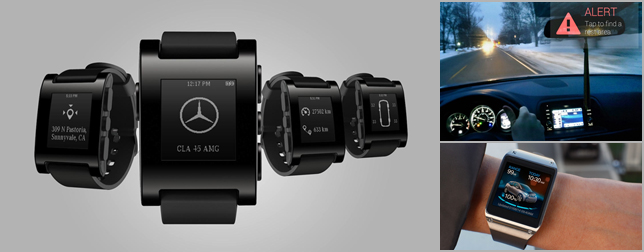Wearables offer great opportunities to enhance your driving experience. During the past few months, several car manufacturers have developed apps that leverage the potential of smartwatches and smartglasses or have even presented their own wearable concepts. Here’s how your favorite wearables might soon enhance your ride and provide you with more comfort and control in your car or even while planning your trip.
Smartwatches and the Car
Mercedes’ DriveStyle smartphone apps provide information such as the position of the car, door lock status or even fuel level from a distance. With its cooperation with Pebble, Mercedes now wants to bring the same information to smartwatches while adding a few new features which can easily be controlled from your wrist. With the Pebble app concept, Mercedes drivers can use their smartwatches to report accidents they’ve come across and receive real-time alerts of road hazards with a buzzer on their wrist. The DriveSteel app works with all Mercedes models manufactured after 2009 which have the Mercedes drive kit plus installed.
For its first electric car, the i3, BMW has developed a smartwatch app for the Galaxy Gear that lets drivers monitor their car’s vitals and also control its features from a distance. The app, which has been presented at CES for the first generation of Samsung’s smartwatch, lets you check the battery status and driving range along with the status of the doors and windows and displays notifications of service or inspection needs. Another great feature is the ability to remotely control the car’s airconditioning system, so the i3 has already reached the right temperature by the time you want to start your ride.
Nissan has not only looked into developing apps for wearables such as smartwatches and smartglasses but has presented hardware concepts that showcase how wearables could be used to increase the pleasure of driving. The Nismo smartwatch concept measures several car metrics such as average speed and fuel consumption and Nissan is also looking also into monitoring race drivers’ heart-rates in order to detect early signs of fatigue. The smartwatch was presented in a video clip that featured Nissans 331 hp sportscar 370Z. It remains to be seen if one day the two will be sold together.
Smartglasses and the Car
While legislators all over the world are still trying to figure out whether it is safe to use Google Glass while driving, the industry is already working on applications which could make driving more convenient and hopefully safer as well.
Mercedes Benz once again became a pioneer when it announced its Glassware project for easier navigation with the Google Glass back in 2013. The system, which has not been released yet, basically works as a door-to-door navigation and allows the smartglasses’ and car’s navigation system to work together seamlessly. With this approach, Mercedes does not necessarily intend Glass to replace the car’s built-in navigation system while driving but rather suggests the driver can use the Glass after having parked the car to receive navigation support for the last few meters automatically pushed to his smartglasses.
The augmented reality company Metaio and car manufacturer Audi presented a quite different idea. Based on Metaios augmented reality smartphone app for A 3 drivers, a concept application for Google Glass goes a step further and positions the car’s instruction manual directly in front of the driver’s line of vision. The prototype system can run its users through service procedures, such as refilling the washing fluid. Once the idea has been transferred to actual augmented reality glasses, such as the Epson, Moverio might deliver true value for amateur and professional mechanics alike.
Harman and DrifeSave both expect Google Glass to become legal for use while driving and have since developed Glassware which actually makes driving more convenient and safe. Harman’s advanced driver assistance system (ADAS) analyses real-time camera data and alerts drivers of potential safety threats, such as impending collisions and unexpected obstacles, directly on their smartglasses. DrifeSave, on the other hand, wants to prevent the driver from falling asleep by analyzing head and eyelid movement with the glasses’ built-in accelerometer and infrared camera. When the app detects that you might fall asleep, it helps find a place to rest, thus making it easier to stay safe on the road.
In the not too distant future, wearables might play a big role how we interact with our cars. They will not only deliver information about our car’s position and status and enable door-to-door navigation. Wearables might soon enable new, convenient ways of accessing our vehicles while self-driving cars – the sci-fi dream we have all been waiting for will be coming out in just a few years – will allow for many new ways to apply wearables. Feeling relaxed, stressed or sleepy while driving? Your car’s selfdriving super-brain might check your vital signs measured by wearables to make sure you are fit to drive, and if it concludes you are not, it might take over the wheel to prevent an accident.















